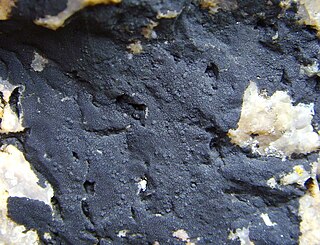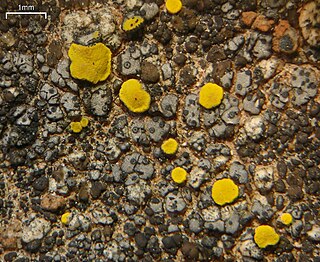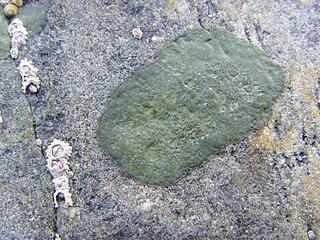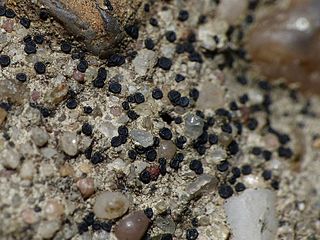
Verrucariaceae is a family of lichens and a few non-lichenised fungi in the order Verrucariales. The lichens have a wide variety of thallus forms, from crustose (crust-like) to foliose (bushy) and squamulose (scaly). Most of them grow on land, some in freshwater and a few in the sea. Many are free-living but there are some species that are parasites on other lichens, while one marine species always lives together with a leafy green alga.

Verrucaria is a genus of lichenized (lichen-forming) fungi in the family Verrucariaceae.

Hydropunctaria maura, still often called by the older name Verrucaria maura and commonly known as tar lichen, is a species of saxicolous (rock-dwelling), crustose lichen belonging to the family Verrucariaceae. A perennial species that does not experience seasonal variations, it is the type species of the genus Hydropunctaria. The medulla is a black basal layer that forms columns to the upper surface and isolates the algae into pockets near the upper surface. The black band formed by H. maura can often be seen at a distance as a marker of the high water point.

Verrucaria nigrescens is a widespread species of crustose lichen in the family Verrucariaceae. It was first formally described as a new species by Christiaan Hendrik Persoon in 1795. The lichen produces a very dark brown thallus that grows on rocks; the medulla is black. There are black perithecia that resemble buried dots, and which measure 0.15–0.3 mm in diameter. Ascospores measure 14–24 by 7–11 μm.

Hydropunctaria is a genus of saxicolous (rock-dwelling), crustose lichens in the family Verrucariaceae. The genus includes both aquatic and amphibious species, with members that colonise either marine or freshwater habitats. The type species, Hydropunctaria maura, was formerly classified in the large genus Verrucaria. It is a widely distributed species common to littoral zones. Including the type species, five Hydropunctaria lichens are considered marine species: H. adriatica, H. amphibia, H. aractina, H. orae, and H. oceanica.
Verrucaria vitikainenii is a species of saxicolous (rock-dwelling) crustose lichen in the family Verrucariaceae. It is found in Finland, where it occurs on calcareous rock outcrops.
Verrucaria oulankaensis is a rare species of saxicolous (rock-dwelling) crustose lichen in the family Verrucariaceae. It is found in north-eastern Finland, where it occurs on calcareous rocks on river shores.
Verrucaria ahtii is a species of saxicolous (rock-dwelling) crustose lichen in the family Verrucariaceae. It is found in Finland, Lithuania, Russia, and Switzerland, where it occurs on calcareous pebbles.
Verrucaria takagoensis is a species of saxicolous (rock-dwelling), crustose lichen in the family Verrucariaceae. Found in semi-freshwater habitats in Chiba Prefecture, central Japan, it was formally described as a new species in 2001 by lichenologist Hiroshi Harada. The lichen has almost spherical, exposed black perithecia measuring 0.1–0.2 mm in diameter, with brownish-black perithecial walls, and lacking a distinct involucrellum. The periphyses are 5–10 μm long with pointed apices, while its ascospores measure 6–8 by 4–5 μm. Verrucaria takagoensis has a translucent or almost transparent (semipellucid) brownish, thin thallus.
Verrucaria kiyosumiensis is a species saxicolous (rock-dwelling), crustose lichen in the family Verrucariaceae. Found in semi-freshwater habitats in Chiba Prefecture, central Japan, it was formally described as a new species in 2001 by lichenologist Hiroshi Harada. The lichen has almost spherical, exposed black perithecia measuring 0.15–0.25 mm in diameter, and dark purplish brown perithecial walls lacking a distinct involucrellum. The periphyses are 10–15 μm long with pointed apices, and its ascospores have dimensions of 12–16 by 5–7 μm. The lichen has an indistinct thallus.
Hydropunctaria oceanica is a species of crustose lichen in the family Verrucariaceae. It is a marine lichen. Found in Great Britain, it was formally described as a new species in 2012 by lichenologist Alan Orange. The type specimen was collected near Haverfordwest, where it was found growing on siliceous rocks on the seashore. It has also been recorded in Ireland. The species epithet oceanica refers to its growth near the ocean. The lichen is similar in appearance, and often grows contiguously with the common and widespread littoral zone lichen Hydropunctaria maura, but is genetically distinct from that species.
Hydropunctaria orae is a species of saxicolous (rock-dwelling), crustose lichen in the family Verrucariaceae. It is a marine lichen. Found in Great Britain, it was formally described as a new species in 2012 by lichenologist Alan Orange. The type specimen was collected near Haverfordwest, where it was found growing on steep rocks on northwest-facing seashore. It has also been recorded in Ireland. The species epithet orae is derived from the Latin ora. The lichen has a thin, dull mid green to dark greenish-grey thallus that is roughened by tiny warts (punctae) measuring 20–40 μm wide.

Verrucaria bernaicensis is a species of saxicolous (rock-dwelling), crustose lichen in the family Verrucariaceae. It was first formally described by Alexandre François Malbranche in 1869. It has a dull, pale grey thallus that is areolate to somewhat squamulose in form. Its perithecia are immersed in the substrata, measure 0.2–0.3 mm in diameter, and lack an involucrellum. Its ascospores are broadly ellipsoid to roughly spherical, measuring 9–11 by 7–9 μm. The lichen has been recorded from Asia, a few European countries, Russia and the Caucasus, and southwestern North America.

Wahlenbergiella mucosa is a species of saxicolous (rock-dwelling), crustose lichen in the family Verrucariaceae. It is a marine species that grows in the littoral zone, and therefore remains immersed in seawater for extended periods. Its photobiont partner is the green alga Paulbroadya petersii.
Wahlenbergiella tavaresiae is a species of saxicolous (rock-dwelling), crustose lichen in the family Verrucariaceae. Known from several locations in the San Francisco Bay area of the United States, it is a marine lichen that inhabits intertidal zones, and as such is immersed in seawater on a regular basis. Associated algal species include the red algae Hildenbrandia and Mastocarpus papillatus, and the brown algae Pelvetiopsis and Fucus. Petroderma maculiforme, a brown alga, is the photobiont partner in the lichen.

Verrucaria muralis is a species of saxicolous (rock-dwelling, crustose lichen in the family Verrucariaceae. It is a common species with an almost cosmopolitan distribution, occurring in an altitudinal range extending from the lowlands to the subalpine zone. It grows on calcareous rocks and walls. It was first formally described as a new species in 1803 by Swedish lichenologist Erik Acharius.
Verrucaria simplex is a species of saxicolous (rock-dwelling), crustose lichen in the family Verrucariaceae. Found in Europe and Asia, it was described as new to science in 1988 by lichenologist Patrick McCarthy. The type specimen was collected by Brian Coppins from Morpeth, Northumberland; there, it was found growing on a fragment of mortar-cement lying on the floor of a woodland. The lichen was later reported from the Czech Republic, and Korea.
Verrucaria nodosa is a species of saxicolous (rock-dwelling), crustose lichen in the family Verrucariaceae. Found in freshwater habitats in Wales, it was formally described as a new species in 2013 by lichenologist Alan Orange. The type specimen was collected by the author north-west of Llanuwchllyn, Merioneth, where it was found growing on an unshaded rock in a stream. The lichen has a grey-green to dark brown thallus with an uneven surface crust. Its ascomata are in the form of somewhat convex to hemispherical perithecia measuring 220–460 μm in diameter, with an inconspicuous or tiny ostiole. Ascospores are ellipsoid and colourless, lack any septa, and typically measure 20.5–22.2–24.0 by 90–97–105 μm. The species is known only from a few streams in Wales, where it grows on shaded or lightly shaded rocks. Associated lichen species include Ionaspis lacustris, Rhizocarpon lavatum, Porpidia hydrophila, Sporodictyon cruentum, and Trapelia coarctata, as well as the mosses Racomitrium aciculare and Scapania undulata.
Verrucaria kowenensis is a species of terricolous (ground-dwelling), crustose lichen in the family Verrucariaceae. It is found in the Australian Capital Territory of Australia, where it grows on silica-rich soil.

Verrucaria viridula is a common and widely distributed species of saxicolous (rock-dwelling), crustose lichen in the family Verrucariaceae. Although it is a somewhat morphologically variable species, two persistent distinguishing characteristics are its relatively large perithecia, which are often curved into a beak, and its large ascospores.








